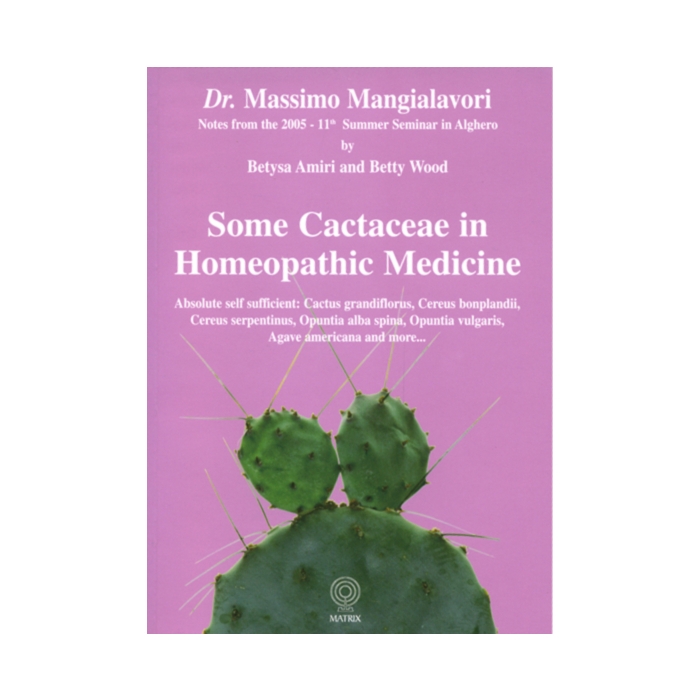Some Cactaceae in Homeopathic Medicine
Share on social media
| ISBN | 9788888799186 |
|---|---|
| Author | Massimo Mangialavori |
| Type | Paperback |
| Language | English |
| Publication date | 2006-01-01 |
| Pages | 121 |
| Publisher | Matrix |
| Review | This book review is reprinted from Volume 21, Spring 2008 edition, with permission from Homeopathic Links. Reviewed by Corrie Hiwat, Netherlands This is a book based on the notes of a Summer School in which the following Cactaceae, through cases, are presented and discussed: Cactus Grandijlorus, Cereus Bonplandi, Cereus Serpentinus. Opuntia Vulgaris, Opuntia Alba Spina and Agave Americana. In his introduction Dr. Mangialavori explains that he often used the cactaceae in near-death situations, where people at the end of their life need to be helped to face the inevitable. The concept of destructiveness is evident in this remedy group and throughout the book we can read about how this destructiveness came about. This is a book about a particular group of remedies in a particular family; as such it provides very condensed and interesting information. The main theme of this group of remedies is self-sufficiency. The cases and related materia medica help us to understand where this quality, in its pathological form, can lead to. The book has six chapters, namely: In the chapter "Hierarchy" the author delves more deeply into the finer characteristics of the remedies with sub-themes. Through these sub-themes the remedy picture becomes very clear, while the included full cases are a great extra help. Here the materia medica comes alive! The reader must be aware that this book is based on notes from a seminar. So it's not perfect in the sense that it was especially written as a book. In effect, the seminar became a book. So, the flow is not always perfect; there are some mistakes that could have been avoided or taken out by more careful translation and proofreading, but there's no need to be disturbed by this. The book will provide the interested reader just what (s)he wants and needs: This compact totality allows us to prescribe these remedies in practice with confidence. What more do we need? There are photographs of each remedy included at the back of the book. |
Review
This book review is reprinted from Volume 21, Spring 2008 edition, with permission from Homeopathic Links.
Reviewed by Corrie Hiwat, Netherlands
This is a book based on the notes of a Summer School in which the following Cactaceae, through cases, are presented and discussed:
Cactus Grandijlorus, Cereus Bonplandi, Cereus Serpentinus. Opuntia Vulgaris, Opuntia Alba Spina and Agave Americana.
In his introduction Dr. Mangialavori explains that he often used the cactaceae in near-death situations, where people at the end of their life need to be helped to face the inevitable.
The concept of destructiveness is evident in this remedy group and throughout the book we can read about how this destructiveness came about.
This is a book about a particular group of remedies in a particular family; as such it provides very condensed and interesting information.
The main theme of this group of remedies is self-sufficiency.
The cases and related materia medica help us to understand where this quality, in its pathological form, can lead to.
The book has six chapters, namely:
. Introduction
. The Plants
. Hierarchy of homeopathic symptoms
. Homeopathic description of the Cactus
. Six cases
. Summary of Cactaceae
In the chapter "Hierarchy" the author delves more deeply into the finer characteristics of the remedies with sub-themes. Through these sub-themes the remedy picture becomes very clear, while the included full cases are a great extra help. Here the materia medica comes alive!
The reader must be aware that this book is based on notes from a seminar. So it's not perfect in the sense that it was especially written as a book. In effect, the seminar became a book.
So, the flow is not always perfect; there are some mistakes that could have been avoided or taken out by more careful translation and proofreading, but there's no need to be disturbed by this. The book will provide the interested reader just what (s)he wants and needs:
. A group of remedies previously unknown to most of us.
. Thorough materia medica supported by well-documented cases.
This compact totality allows us to prescribe these remedies in practice with confidence.
What more do we need?
There are photographs of each remedy included at the back of the book.


